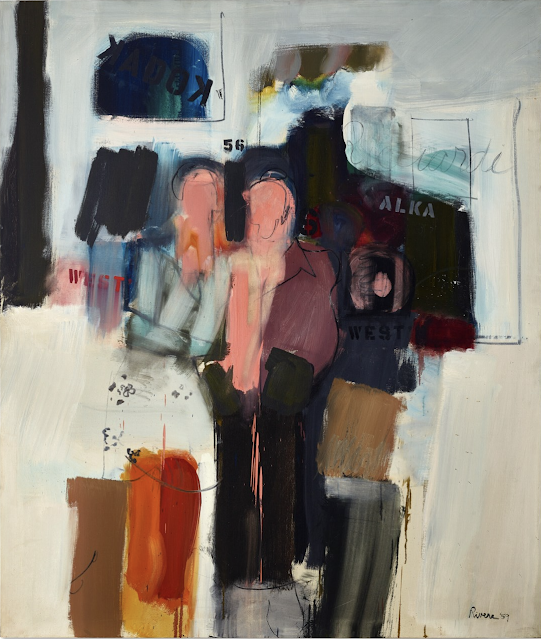A STUDIO VISIT WITH MR. PAINTERLY,
LARRY RIVERS
b. 1923 Bronx New York d. 2002 New York
THE EARLY WORKS
1950s–60s
Larry Rivers was a master of the “lost and found” approach—his lines flickering in and out of clarity like memory itself. With an expressive, intuitive hand, he moved through his compositions as if drawing and painting were one seamless act. His subjects feel alive, caught in the immediacy of the moment—vivid, spontaneous, and brimming with energy.
– Eye likey
ABOUT
Larry Rivers was raised in the Bronx, a painter sculptor printmaker poet and musician at the crossroads of Abstract Expressionism and Pop art who bucked prevailing trends in favor of a more singular style. The son of Ukrainian Jewish immigrants has given name was Yitzroch Loiza (Irving) Grossberg until age 17 when a nightclub emcee announced his band as “Larry Rivers and the Mud Cats.” He adopted the name that same year. Following a brief stint in the U.S. Army Rivers spent a year at the Juilliard School of Music studying musical theory and composition. He then pursued his only formal artistic training at Hans Hofmann’s painting school in New York from 1947 to 1948. Countering the vogue for abstraction at the time Hofmann’s approach emphasized drawing as the foundation of all art making and presented the old masters as rich resources for creative exchange. In 1951 Rivers received a BA in art education from New York University. Proceeding from the conviction that figuration was not antithetical to modernism Rivers completed his first major work The Burial in 1951 signaling the major concerns that he would return to throughout his life. With this painterly restaging of Gustave Courbet’s masterpiece A Burial at Ornans (Un enterrement à Ornans, 1849–50) Rivers began a sustained engagement with canonical paintings imaginatively connecting contemporary art with art history. In works such as Washington Crossing the Delaware (1953) Rivers similarly mined the past for inspiration a few years later he began to take up more contemporary images as in Dutch Masters and Cigars (1964) which was partly copied from a cigar box that itself depicted Rembrandt’s 1662 painting The Syndics of the Clothmakers’ Guild (De Staalmeesters). Subsequently Rivers made several works that combine sculpture and painting including I Like Olympia in Blackface (1970) which reverses the roles of Édouard Manet’s Olympia and her African servant. Later that decade Rivers began appropriating his own work from the 1950s and 1960s with the series Golden Oldies (1978–79). In an interview with his close friend the poet Frank O’Hara Rivers illuminated the premises of his approach saying “I think of a picture of a smorgasbord of the recognizable.”¹ Two of his largest projects adopted broad historical themes. The History of the Russian Revolution from Marx to Mayakovsky (1965) an enormous mixed-media assemblage incorporated painted portraits architectural cutouts stenciled lettering and found objects. The monumental History of Matzah: The Story of the Jews (1984–85) also used text and three-dimensional relief elements this time to narrate Jewish history from Moses to Theodore Herzl the founder of Zionism. Rivers’s first major survey was organized by the Rose Art Museum Brandeis University Waltham Massachusetts in 1965 it traveled to the Pasadena Art Museum Jewish Museum New York Detroit Institute of Arts and Minneapolis Institute of Arts. A retrospective of his paintings and drawings opened at the Butler Institute of American Art Youngstown Ohio in 1990 and toured the United States for a further two years with stops in the Norton Gallery of Art West Palm Beach Florida Fort Wayne Museum of Art Indiana Scottsdale Center for the Arts Arizona and J. B. Speed Art Museum Louisville Kentucky. In 1997 the Philharmonic Center for the Arts Naples Florida staged a retrospective of the works Rivers made between 1980 and 1997. His most comprehensive retrospective to date was at the Corcoran Gallery of Art in Washington D.C. in 2002. Rivers continued painting up until three months before his death in Southampton, New York on August 14 2002.
- special thanks to the Guggenheim Museum
Larry's studio visit,
South Hampton NY
circa 1962-1964
by American photographer, BOB ADELMAN
You just saw the #PAINTERSCRUSH #SNAPCRACKLEPOP WORKS OF
LARRY RIVERS



















































